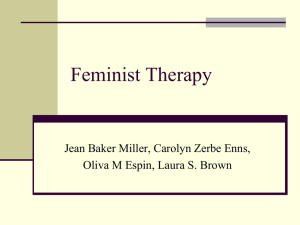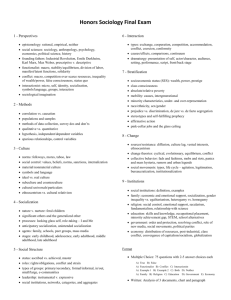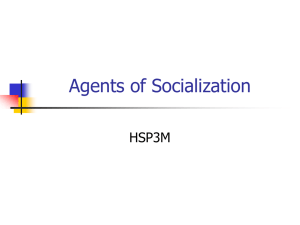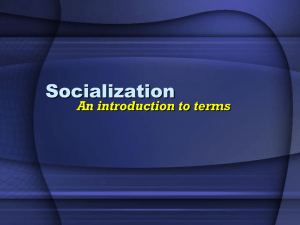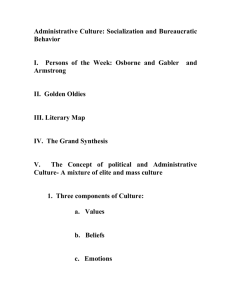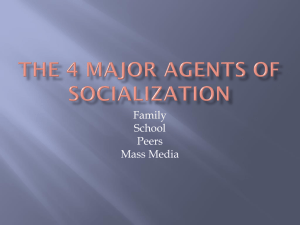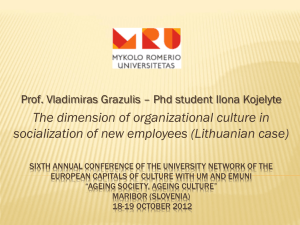FAML 430 Week 1 - I
advertisement
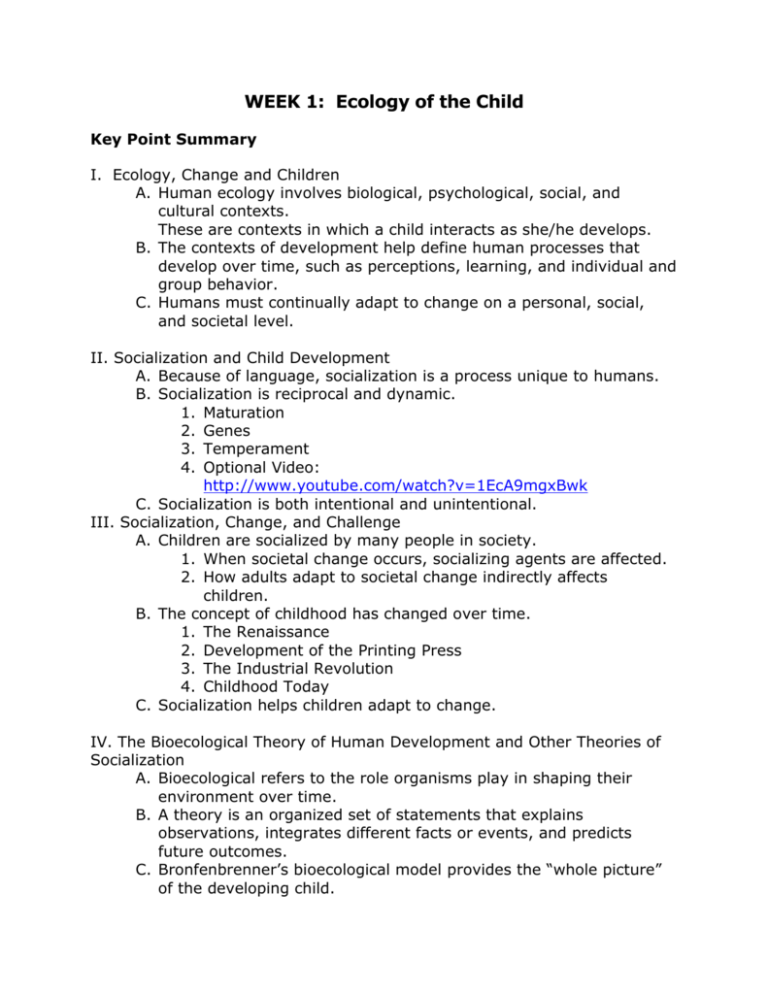
WEEK 1: Ecology of the Child Key Point Summary I. Ecology, Change and Children A. Human ecology involves biological, psychological, social, and cultural contexts. These are contexts in which a child interacts as she/he develops. B. The contexts of development help define human processes that develop over time, such as perceptions, learning, and individual and group behavior. C. Humans must continually adapt to change on a personal, social, and societal level. II. Socialization and Child Development A. Because of language, socialization is a process unique to humans. B. Socialization is reciprocal and dynamic. 1. Maturation 2. Genes 3. Temperament 4. Optional Video: http://www.youtube.com/watch?v=1EcA9mgxBwk C. Socialization is both intentional and unintentional. III. Socialization, Change, and Challenge A. Children are socialized by many people in society. 1. When societal change occurs, socializing agents are affected. 2. How adults adapt to societal change indirectly affects children. B. The concept of childhood has changed over time. 1. The Renaissance 2. Development of the Printing Press 3. The Industrial Revolution 4. Childhood Today C. Socialization helps children adapt to change. IV. The Bioecological Theory of Human Development and Other Theories of Socialization A. Bioecological refers to the role organisms play in shaping their environment over time. B. A theory is an organized set of statements that explains observations, integrates different facts or events, and predicts future outcomes. C. Bronfenbrenner’s bioecological model provides the “whole picture” of the developing child. D. The bioecological model of human development comprises information related to the persons, processes, contexts, and outcomes. V. Examining Socialization in an Ecological Context A. According to Bronfenbrenner, the social context(s) of individual interactions and experiences determine(s) the degree to which individuals can develop their abilities and realize their potential. B. In Bronfenbrenner’s model, there are four basic structures in which relationships and interactions take place to form patterns that affect human development. 1. The microsystem refers to activities and relationships with significant others experienced by a developing person in a particular small setting such as family, school, peer group, or community. 2. The mesosystem refers to linkages and interrelationships between two or more of a person’s microsystems. a. Example: the family and the school, or the family and the peer group b. Impact depends on number and quality of interactions. 3. The exosystem refers to settings in which children do not actually participate, but which affect them in one of their microsystems. a. Example: parents’ jobs; city council 4. The macrosystem refers to the society and subculture to which the developing person belongs, with particular reference to the belief systems, lifestyles, patterns of social interaction, and life changes. a. Low context macrosystems are individualistic-oriented while high-context macrosystems are collectivistically oriented. b. Low-context and high context macrosystems differ in ways of perceiving, believing, behaving, and judging. VI. Interaction of Ecological Systems over Time: The Chronosystem A. The chronosystem refers to temporal changes in ecological systems or within individuals, producing new conditions that affect development. 1. Significant historical events influence development. 2. Development is also influenced by contemporary, ongoing events. VII. Contemporary Ecology A. Contemporary societal trends affect the future of families and children. B. Contemporary societal trends affect how people use available resources. C. Each year the federal government issues a report, America’s Children: Key National Indicators of Well-Being to document the ecological impact and changes to the well-being of children. Gospel Connection Socialization in Zion A. “And the Lord called His people Zion, because they were of one heart and one mind and dwelt in righteousness; and there were no poor among them.” (Moses 7:17-18) B. The 1936 First Presidency statement regarding the welfare program of the church established an opportunity for establishing the ideal of Zion. C. The Foundational truths of Zion are: a. Love b. Service c. Work d. Self-Reliance e. Consecration f. Accountability D. The Celestial Nature of Self-Reliance a. Since the beginning of time man has been counseled to earn his own way. b. Well-meaning programs are shortsighted if they are designed to help people rather than to help people help themselves. c. Story: Seagulls are gullible if they rely on the easy food of shrimp boats. d. Self-reliance is not the end, but a means to an end. It puts us in a position where we can serve others. E. The Keys to Socialization in Zion a. The measure of our love for our fellowman, and in a large sense, for the Lord, is what we do for one another and for the poor and distressed. b. Work brings happiness, self-esteem, and prosperity. It is the means of all accomplishment. We are commanded to work. c. The responsibility for each member’s social, emotional, spiritual, physical, or economic well-being rests first upon himself, second upon his family, and third upon the Church. d. Consecration encompasses sacrifice. It is the giving of one’s time, talents, and means to care for those in need—whether spiritually or temporally—and in building the Lord’s kingdom. e. Each member should contribute a generous fast offering for the care of the poor and the needy. If we do, we shall increase our own prosperity both spiritually and temporally.
